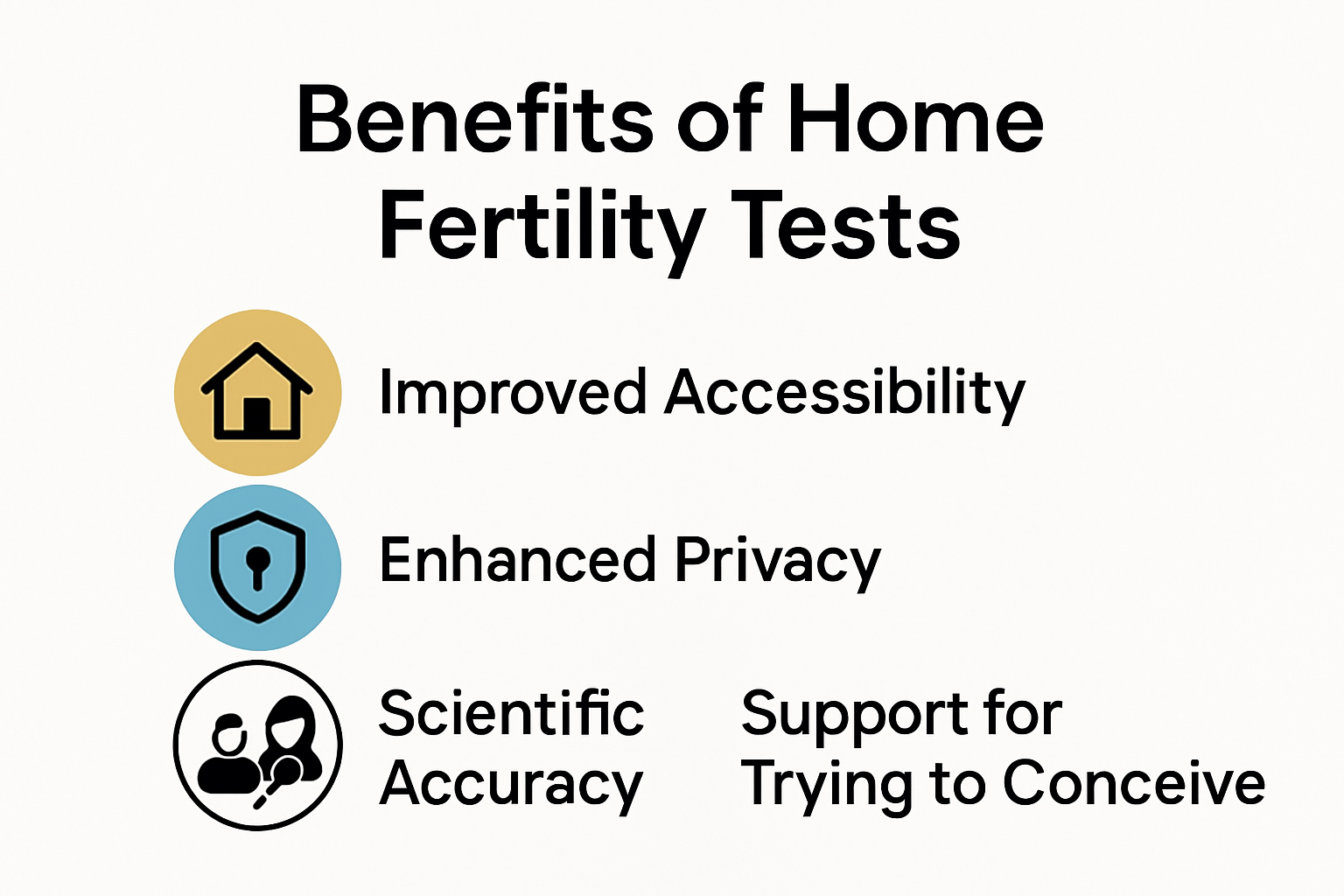Home fertility tests are changing the way people handle reproductive health. The numbers do not lie. A recent study shows that 88 percent of users found home fertility prediction tools highly useful, rating them over 7 out of 10 in satisfaction. This might sound like just another tech upgrade. But here is where things get interesting. For 2025, the real headline is that home fertility tests are not just about convenience or privacy. They are giving couples and individuals control over health decisions in ways never possible in a clinic.
Table of Contents
- Understanding Home Fertility Tests Today
- Convenience And Privacy For Vasectomy Confirmation
- How Tests Support Couples Trying To Conceive
- Role In Urology Clinics And Patient Care
Quick Summary
| Takeaway | Explanation |
|---|---|
| Home fertility tests enhance accessibility | Modern home fertility tests provide a convenient and private alternative to clinical assessments, empowering individuals to monitor their fertility easily from home. |
| Scientific accuracy has improved | Advanced testing technologies can now deliver reliable hormone level measurements and sperm quality assessments comparable to traditional labs, ensuring users receive precise reproductive health insights. |
| Support for couples trying to conceive | Home tests help couples identify fertility windows and assess reproductive health, facilitating informed decisions and reducing stress in the conception journey. |
| Vasectomy confirmation is streamlined | At-home semen analysis tests significantly improve patient compliance and comfort, offering an efficient way for men to verify the success of their vasectomy without multiple clinic visits. |
| Transforming urology clinic practices | Home fertility tests are becoming integral in urology clinics, enhancing patient experience and allowing for personalized, technology-driven care that respects patient privacy. |

Understanding Home Fertility Tests Today
Home fertility tests have revolutionized how individuals and couples approach reproductive health monitoring. These innovative diagnostic tools provide a private, convenient method for assessing fertility potential without the traditional barriers of clinical settings.
The Evolution of At-Home Fertility Diagnostics
Modern home fertility tests represent a significant leap forward in personal health technology. According to research from the University of Chicago’s Pritzker School of Molecular Engineering, emerging handheld devices can now accurately measure hormone levels with lab-quality precision in just minutes. This breakthrough means individuals can obtain critical reproductive health insights from the comfort of their own home.
Traditionally, fertility assessments required multiple clinic visits, extensive waiting times, and significant financial investment. Contemporary home testing kits have transformed this landscape by offering accessible, affordable alternatives. A comprehensive study published in Fertility and Sterility revealed that 88% of patients using home fertility prediction methods found them highly useful, with an average utility score of 7.2 out of 10.
Scientific Accuracy and Technological Advancements
The scientific community has increasingly validated the reliability of home fertility testing. Modern kits can detect critical fertility markers with remarkable accuracy. For instance, advanced tests can measure hormone levels such as luteinizing hormone (LH), which signals ovulation, or analyze sperm count and motility with precision comparable to clinical laboratories.
A randomized controlled trial in Reproductive BioMedicine Online highlighted that tailored fertility education significantly enhances individuals’ understanding of their reproductive health. Home fertility tests play a crucial role in this educational process, empowering users with immediate, actionable insights.
Technological innovations have made these tests increasingly sophisticated. Microfluidic technologies and advanced biochemical sensors now allow for complex hormone and fertility marker analysis using minimal biological samples. Some cutting-edge tests can provide comprehensive reproductive health assessments using just a few drops of blood or a small semen sample.
Privacy and Convenience: A New Paradigm
Home fertility tests address multiple user needs beyond clinical assessment. They offer unprecedented privacy and discretion, eliminating uncomfortable clinical interactions. Users can collect samples in the most comfortable environment possible - their own home. The entire process typically involves simple steps: collecting a sample, following precise instructions, and receiving secure digital results within days.

Moreover, these tests democratize access to reproductive health information. Individuals who might feel intimidated by traditional medical settings can now proactively monitor their fertility status. Learn more about our comprehensive fertility test kit options to understand how modern technology is transforming personal health monitoring.
As reproductive technology continues advancing, home fertility tests represent more than just diagnostic tools. They symbolize a broader shift towards personalized, accessible healthcare - putting critical medical insights directly into individuals’ hands.
To help you compare the traditional clinic-based approach and modern home fertility testing, here’s a table summarizing their main differences.
| Feature | Traditional Clinic Testing | Home Fertility Tests |
|---|---|---|
| Accessibility | Requires multiple appointments | Conducted at home, anytime |
| Privacy | Clinical environment, limited privacy | High; sample collected privately at home |
| Cost | Often higher (visit fees, labs) | Generally more affordable |
| Waiting Time | Can take days or weeks | Rapid or immediate results |
| Technology | Standard lab equipment | Microfluidics, digital sensors |
| User Comfort | Often perceived as uncomfortable | More comfortable, stress-free |
Convenience and Privacy for Vasectomy Confirmation
Vasectomy confirmation represents a critical step in male reproductive health, and home fertility tests have transformed this process by offering unprecedented convenience and privacy for men seeking post-procedure verification.
The Critical Need for Post-Vasectomy Semen Analysis
After a vasectomy, confirming the procedure’s success is essential to prevent unintended pregnancy. Research published in medical journals indicates that home-based post-vasectomy semen analysis (PVSA) tests can significantly improve patient compliance compared to traditional clinical methods.
Traditionally, men were required to schedule multiple clinical appointments, collect samples in uncomfortable medical settings, and wait weeks for results. Home testing eliminates these barriers. According to the American Urological Association, while self-administered tests are FDA-approved, they require careful instruction to ensure accurate use and interpretation.
Technological Precision in Home Testing
Modern home fertility tests for vasectomy confirmation offer remarkable accuracy. A definitive study in the Journal of Urology demonstrated that specialized home tests like SpermCheck Vasectomy achieve an impressive 96% accuracy in identifying sperm counts below 250,000 per milliliter.
These advanced tests provide men with a scientifically validated method to confirm their vasectomy’s effectiveness without multiple clinic visits. The process involves collecting a sample at home, following precise instructions, and receiving secure digital results within days.
Privacy and Psychological Comfort
Beyond technical accuracy, home fertility tests for vasectomy confirmation address significant psychological needs. Privacy becomes paramount in medical testing, especially regarding reproductive health. Men often feel uncomfortable discussing fertility or collecting samples in clinical environments.
Home testing transforms this experience by allowing complete discretion. Users can complete the entire process in the most comfortable setting possible - their own home. Explore our comprehensive guide to home testing options to understand how technology is revolutionizing post-vasectomy verification.
Moreover, these tests democratize medical information. They empower men to take proactive control of their reproductive health without navigating complex medical systems or experiencing potential embarrassment associated with traditional testing methods.
As medical technology continues advancing, home fertility tests for vasectomy confirmation represent more than a diagnostic tool. They symbolize a broader shift towards patient-centered, dignified, and accessible healthcare solutions.
Below is a table outlining the step-by-step process of home vasectomy confirmation testing for easy reference.
| Step | Description |
|---|---|
| 1 | Collect semen sample at home following kit instructions |
| 2 | Apply the sample to the designated testing device/test cassette |
| 3 | Wait the recommended time (often minutes) for results to process |
| 4 | Interpret results as per included guide or receive digital notification |
| 5 | Report or share results with your clinician if required for medical records |
How Tests Support Couples Trying to Conceive
Home fertility tests have become powerful tools for couples navigating the complex journey of conception, offering unprecedented insights and support throughout their reproductive planning process.
Understanding Fertility Windows and Timing
Identifying the optimal fertility window is crucial for couples trying to conceive. Research published in fertility journals demonstrates that using home ovulation tests to time intercourse can significantly enhance conception efforts without increasing stress levels. These tests provide precise hormonal tracking, helping couples pinpoint the most fertile days in a woman’s menstrual cycle.
Fertility awareness education plays a critical role in this process. Studies indicate that understanding menstrual cycle dynamics empowers couples to make informed reproductive health decisions. Home fertility tests transform complex medical information into accessible, actionable insights that couples can easily interpret and apply.
Comprehensive Reproductive Health Assessment
Modern home fertility tests go beyond simple ovulation prediction. They offer comprehensive assessments of both male and female reproductive health. For men, advanced sperm function tests can evaluate critical parameters like sperm count, motility, and overall quality.
For women, these tests can track multiple fertility markers, including luteinizing hormone (LH) levels, which signal impending ovulation. This multi-dimensional approach provides a more holistic view of reproductive potential, helping couples understand their unique fertility landscape.
Emotional Support and Communication
Beyond medical data, home fertility tests offer significant emotional benefits. The process of testing together can strengthen communication between partners, transforming fertility monitoring from a potentially stressful experience into a collaborative journey. Shared knowledge reduces anxiety and creates a sense of mutual understanding and support.
Private, at-home testing eliminates many of the awkward and intimidating aspects of traditional fertility assessments. Couples can explore their reproductive health in the most comfortable environment possible - their own home. Learn more about how our comprehensive fertility test kits support couples in their conception journey.
These tests democratize reproductive health information, giving couples unprecedented access to insights that were previously only available through extensive clinical testing. By providing clear, actionable data, home fertility tests empower couples to take proactive steps in their family planning process.
As reproductive technology continues to advance, home fertility tests represent more than diagnostic tools. They are catalysts for informed decision-making, helping couples navigate the complex and deeply personal journey of trying to conceive with greater confidence and understanding.
Role in Urology Clinics and Patient Care
Home fertility tests are rapidly transforming the landscape of urology clinics, offering innovative solutions that enhance patient care, streamline diagnostic processes, and improve overall patient experience.
Revolutionizing Diagnostic Approaches
Traditional urological diagnostics often involve complex, time-consuming processes that can be intimidating for patients. Research from the American Urological Association emphasizes the critical need for comprehensive male infertility evaluations. Home fertility tests provide a complementary approach that seamlessly integrates with clinical protocols.
A groundbreaking study highlighted that home-collected semen samples yield results comparable to clinic-collected samples in terms of sperm concentration and DNA fragmentation. Clinical research published on ResearchGate demonstrates that this approach not only maintains scientific accuracy but also significantly increases patient satisfaction.
Enhanced Patient Experience and Accessibility
Urological clinics are increasingly recognizing the value of home fertility testing as a patient-centric solution. The University of Illinois Health offers innovative solutions like the OverNiteMale® Kit, allowing patients to collect semen samples at home and send them directly to laboratory testing, dramatically improving accessibility and convenience.
This approach addresses several key patient concerns. Privacy becomes a primary advantage, eliminating the discomfort associated with on-site sample collection. Patients can now complete critical diagnostic steps in the most comfortable environment possible - their own home. Explore our comprehensive guide to home testing integration to understand how technology is transforming urological patient care.
Technological Integration and Future Potential
Modern urology clinics are embracing home fertility tests as a powerful diagnostic tool. These tests offer clinicians comprehensive data sets that can be easily integrated into patient records, providing a more holistic view of reproductive health. The ability to collect precise measurements without the stress of clinical environments represents a significant advancement in patient-centered care.
The integration of home fertility tests into clinical practice demonstrates a broader shift towards personalized, technology-driven healthcare. Urologists can now offer patients more flexible, comfortable, and efficient diagnostic options that align with contemporary healthcare expectations.
As medical technology continues to evolve, home fertility tests are poised to become an essential component of comprehensive urological care. They represent more than just a diagnostic convenience - they are a testament to the ongoing transformation of patient-centered medical approaches, empowering individuals to take an active role in understanding and managing their reproductive health.
Frequently Asked Questions
What are the main benefits of home fertility tests?
Home fertility tests provide convenience, privacy, and accurate assessments of reproductive health, allowing individuals to monitor fertility from the comfort of their homes.
How accurate are home fertility tests compared to clinical tests?
Modern home fertility tests can deliver scientific accuracy comparable to traditional lab tests, particularly in measuring hormone levels and sperm quality.
Can home fertility tests help couples trying to conceive?
Yes, home fertility tests help couples identify their most fertile windows and provide comprehensive reproductive health assessments, thus supporting their conception efforts.
How do home tests assist with post-vasectomy verification?
Home fertility tests for vasectomy confirmation allow men to conduct semen analysis at home, ensuring privacy while providing accurate results to verify the success of the procedure.
Recommended
- Fertility Test Kit Benefits: Accurate Results for Vasectomy & Concepti
- Fertility Test Kit Components: Guide for Vasectomy and Couples
- Sperm Function Tests Guide: Fertility, Vasectomy, and Beyond
- 2025 Guide to Home Testing Kit Components
- Routine Semen Analysis Benefits for Vasectomy and Fertility 2025
- Understanding Semen Testing Kits: A 2025 Guide for Vasectomy and Ferti





